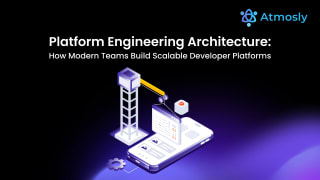A DevOps automation platform is an integrated system that streamlines software delivery by automating build, test, deployment, and infrastructure workflows. Instead of managing multiple disconnected tools for CI/CD, IaC, monitoring, and secrets, teams use a unified platform that brings all these components together.
Modern DevOps automation platforms typically include:
- Continuous Integration/Continuous Delivery (CI/CD): Automates code build, testing, and deployment.
- Infrastructure as Code (IaC): Manages cloud infrastructure via Terraform, Pulumi, or CloudFormation.
- Kubernetes Automation: Handles deployment, scaling, and monitoring of containers.
- Observability: Centralized logging, monitoring, and alerting.
- Security & Governance: Policy enforcement, access control, and compliance automation.
By consolidating these capabilities, teams eliminate manual bottlenecks and enable faster, safer software delivery a critical advantage in today’s multi-cloud, microservices-driven world.
Why Teams Are Switching to Modern DevOps Automation Tools
Many organizations are re-evaluating their DevOps setups because traditional pipelines are too slow, fragile, and fragmented. Here’s why teams are adopting unified platforms in 2025:
- Fragmented toolchains slow down delivery: Managing Jenkins for CI, Terraform for IaC, and ArgoCD for deployments often leads to inefficiencies.
- Manual intervention increases risk: Each manual step introduces opportunities for human error and deployment failures.
- Lack of visibility: With multiple systems, tracking performance and debugging issues becomes harder.
- Scaling challenges: Legacy CI/CD tools struggle with multi-cluster, multi-cloud workloads.
- Rising cloud costs: Automation platforms help right-size workloads, automate scaling, and optimize cloud spend.
As a result, teams are moving toward end-to-end automation platforms that provide unified pipelines, policy control, and a self-service developer experience.
Core Features to Look for in a DevOps Automation Platform
When evaluating platforms, modern DevOps leaders look for tools that balance power, simplicity, and scalability. Here are the must-have capabilities to consider:
1. Unified CI/CD and Deployment Management
A robust CI/CD engine automates build, test, and deploy workflows, ideally with templates, rollback support, and integration with version control systems such as GitHub or GitLab.
2. Kubernetes-Native Automation
Kubernetes is the backbone of modern cloud infrastructure. The best platforms integrate seamlessly with Kubernetes for deployment, autoscaling, and monitoring.
3. Infrastructure as Code (IaC) Integration
Look for Terraform or Pulumi support to manage and provision infrastructure dynamically across AWS, GCP, and Azure.
4. Developer Self-Service
Empowering developers to spin up environments, trigger pipelines, and deploy safely without Ops dependency is a key driver of productivity.
5. Security, Policy, and Governance
Modern platforms include policy-as-code tools (like Open Policy Agent) to enforce security and compliance across deployments.
6. Observability & Monitoring
Integrated monitoring and alerting dashboards (e.g., Prometheus, Grafana) help teams identify issues faster and maintain system reliability.
7. Scalability & Cost Optimization
Cost-aware scheduling, autoscaling, and resource utilization analytics help teams reduce cloud waste.
Top DevOps Automation Platforms in 2025 (Feature Comparison)
Platform | Best For | Key Features | Limitations |
| GitLab | Complete CI/CD pipelines | Integrated source control and CI/CD | Limited for multi-cloud IaC automation |
| Jenkins X | Open-source CI/CD customization | Extensible, community-driven | Complex maintenance, high setup overhead |
| Harness | Enterprise-level automation | Smart deployments, cloud cost visibility | High licensing costs |
| Humanitec | Internal Developer Platforms | Environment orchestration, self-service | Requires integration with existing CI/CD |
| Port.io | Developer self-service and visibility | IDP blueprints, dynamic catalogs | Limited CI/CD orchestration |
| Devtron | Kubernetes-native DevOps | ArgoCD-based workflows, dashboard UI | Focused only on Kubernetes workloads |
| Modern Automation Platforms | All-in-one DevOps orchestration | Unified CI/CD, IaC, policy, and cost control | Newer ecosystem but rapidly evolving |
Pro Tip: The best choice depends on your team’s size, cloud environment, and DevOps maturity. For large teams, all-in-one platforms often provide the highest ROI.
Key Benefits of DevOps Automation Platforms
Adopting a modern automation platform delivers measurable impact across speed, reliability, and developer experience:
- Faster Delivery: Automate manual pipelines and reduce deployment time by up to 70%.
- Improved Consistency: Infrastructure and pipelines-as-code ensure predictable, repeatable results.
- Stronger Security: Policy-as-code and role-based access reduce compliance risks.
- Cost Optimization: Intelligent workload management cuts cloud costs by 20–40%.
- Enhanced Developer Productivity: Self-service environments empower teams to deploy independently.
In short, teams move faster, deploy more safely, and operate more efficiently.
How to Choose the Right DevOps Automation Platform
Selecting the right platform depends on your organization’s size, tech stack, and long-term goals. Use these evaluation factors to guide your decision:
- Integration Capabilities: Ensure compatibility with your CI/CD, IaC, and Kubernetes ecosystem.
- Scalability: Can the platform handle your projected workload and user growth?
- Ease of Use: Developer adoption matters, look for intuitive interfaces and workflow templates.
- Security & Compliance: Check for policy-as-code, RBAC, and secrets management.
- Cost & ROI: Factor in license fees, setup time, and long-term automation savings.
Pro Tip: Run a proof-of-concept (POC) before a full migration. Test the platform’s CI/CD pipeline, deployment flow, and observability integrations with a small application.
The Future of DevOps Automation (2025 and Beyond)
The next generation of DevOps automation will be powered by AI, predictive analytics, and intelligent orchestration. Here’s what’s shaping the future:
- AI-Driven Automation: AI will predict pipeline failures, recommend fixes, and optimize resource allocation.
- Internal Developer Platforms (IDPs): IDPs are becoming the standard for developer self-service and governance.
- Multi-Cloud Orchestration: Future platforms will provide unified management across AWS, Azure, and GCP.
- Policy-as-Code & FinOps Integration: Automation will expand to compliance, cost management, and sustainability.
Teams adopting these trends early will lead the next wave of DevOps innovation.
Conclusion: Automate Smarter, Deliver Faster
DevOps automation platforms have become the cornerstone of modern engineering. They simplify complex toolchains, reduce manual errors, and help teams deliver software at unprecedented speed.
In 2025, successful organizations will not only automate but also orchestrate, integrating CI/CD, IaC, Kubernetes, and AI-driven insights into one cohesive ecosystem.
Ready to modernize your DevOps strategy? Explore how next-gen automation platforms can help your team ship faster, stay secure, and scale efficiently.






